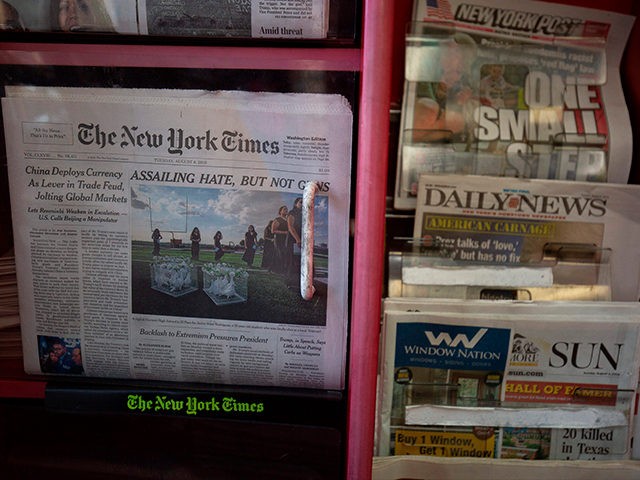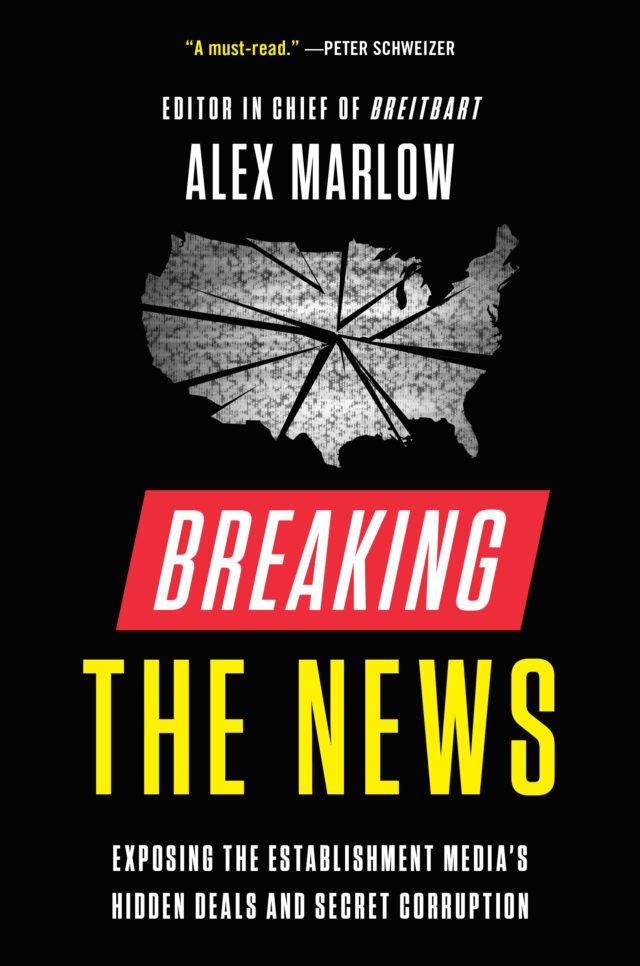Breitbart News Editor-in-Chief Alex Marlow’s Breaking the News: Exposing the Establishment Media’s Hidden Deals and Secret Corruption details the tricks the media use to contort every story to fit their fixed agenda— also known as the rules to properly decipher the New York Times.
Establishment media outlets require something akin to a “secret decoder ring,” Marlow observes in his best-selling blockbuster, which recently landed on the New York Times, USA Today, Wall Street Journal, and Publishers Weekly bestseller lists.
“What is written on the page (or spoken in a broadcast) is not always literal and can only be fully understood if you know how to break the code,” he writes, providing key examples and hacks, or a “cheat sheet,” of how people can better understand the how the establishment media operates and covers the news.
The first tip: “Anything that can be politicized, will be politicized.” Any reporting on subjects that cannot be politicized, which Marlow notes is a “smaller percentage of the paper” in modern times, is typically far more credible.
Outlets, such as the New York Times, are largely driven by promoting “good” narratives while burying “bad” narratives.
“Good news” for a preferred narrative, Marlow explains, usually appears on the front page of the paper, while “bad news” — i.e. news that does not advance the left’s desired narrative — is “deep within the paper.” In some cases, the outlet refuses to cover the bad news at all. Similarly, good news on an “undesirable” narrative also appears deep within the paper, or the outlet fails to cover it at all.
“Bad news about an undesirable narrative is to be treated the same as good news for a preferred narrative,” Marlow notes.
But this practice — of promoting “good” narratives” and burying “bad” ones, goes far beyond story placement. There is a method in the articles themselves, as Breaking the News reveals:
• Within a given article, information that confirms the paper’s preferred narrative is to be featured at the top of the article, ideally in the first sentence.
• Within a given article, information that rebuts a preferred narrative or confirms an undesirable narrative is to appear deep in the article, or not at all.
• An article’s “hero” should be anyone who advances the causes of globalism, wokeness, skepticism of America and its values, and/or political leftism.
• Additional unofficial “hero points” are added or subtracted based on the hero’s race, sex, sexual orientation, and/or socioeconomic status.
• An article’s “villain” is typically anyone in the article who advances the causes of nationalism, conservatism, or traditional American values.
• A villain can also be someone who is insufficiently outraged at those who do not embrace modern woke leftism.
• When someone is a villain, their race, sex, sexual orientation, and/or socioeconomic status are mostly irrelevant unless they can be used to portray the villain in an even more unfavorable light.
• Heroes need not be actual heroes; they can simply be victims.
• Heroes get glamorous “hero shot” photographs when possible.
• Villains get unflattering photographs, or none at all.
• Errors are acceptable, so long as they do not hurt the cause of globalism or modern woke leftism.
•Errors that portray a preferred narrative negatively or an unfavorable narrative positively are never to be made. Ever.
• Corrections are to be published discreetly, deep within the paper, if at all.
Interestingly, Marlow notes that public acknowledgment of corrections or updates is not an intrinsically ethical decision. Rather, it is a strategic business decision, with outlets only drawing attention to their mistakes if it benefits the publication.
“If posting an update or correction mitigates further reputational damage from the mistake or it enhances the paper’s brand, acknowledge the update,” he observes.
Within the articles themselves, the New York Times makes a point to highlight the worst moments of their featured villain in their stories (which happened to be President Trump and his allies over the last four years), even if the negative attributes do not “furnish a fair representation of their life and works.” These negative attributes commonly include “perceived sexism, racism, bigotry, or corruption in their past.” Even if these claims have been discredited, they “must be mentioned.”
The New York Times does the opposite for its perceived heroes, failing to mention their negative attributes while promoting their best ones “even if it does not furnish a fair representation of their life and works.” Unlike the story’s villain, articles highlighting the story’s hero must not mention any past instances of racism, sexism, bigotry, or corruption, Marlow writes:
• Positive attributes are not to be included unless in the context of a “fall from grace” story arc.
• If a hero is mentioned, a thumbnail biography of their best moments and positive attributes must be included in the article, even if it does not furnish a fair representation of their life and works.
• Any past instances of sexism, racism, bigotry, or corruption need not be mentioned.
• Negative attributes are not to be included unless in the context of a triumphant story arc.
Of course, there are far more rules that could be added, as Marlow encourages book buyers to both snap a photo of these rules on their phone to add more deciphering tips to the cheat sheet.
Breaking the News is available now.


COMMENTS
Please let us know if you're having issues with commenting.